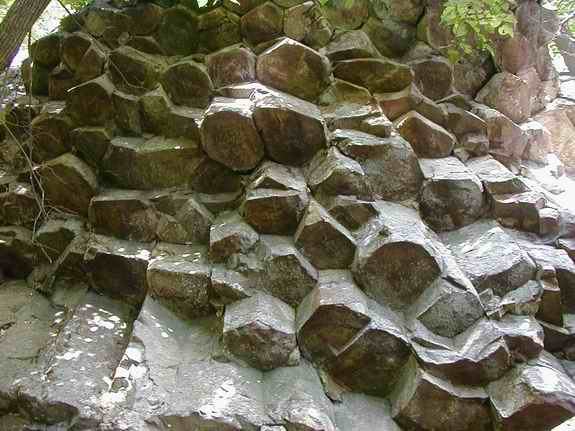|
Columnar Jointing: A geologic feature that consists of a three-dimensional network of fractures that occurs in cooling lava that forms parallel, prismatic columns. The cross-section of the columns is generally pentagonal or hexagonal but there are rare cases of formations with three to twelve sides. In all cases, the columns have six immediate neighbors. The columns are found in igneous rock bodies of basaltic sills and dikes. Potpourri: The distinctive structure of the columnar jointing formation is attributed to stresses that are created when lava cools. If a rising mass of molten lava comes in contact with a flat, cooler surface, the basalt cools rapidly from the outer edge toward the center. Brittle fractures ensue along lines perpendicular to the cooler surface, thus forming the columnar structure. The hexagonal cross sections form preferentially because the hexagon's interior angle of 120 degrees maximizes the amount of elastic energy released. The unusual appearance of columnar jointing caused many early observers to postulate theories as to its origin. One researcher held that magma nucleated around isolated centers to form large plastic balls which yielded the hexagonal symmetry when pressed together. The fact that the shape of the columns was similar to those of quartz crystals led to the belief (called Neptunism for the Roman God of the Sea) that volcanic rocks precipitated from sea water, their clarity depending on the source of the water. Geologists recently discovered that the desiccation (drying out) of a starch-water mixture was analogous to the cooling of basalt, as they both involve the solidification of a viscous liquid. Studies of the relationship between desiccation rate and structure revealed that there is a critical rate for columnar jointing to occur. Higher desiccation rates tend to yield pentagonal shapes in favor of the hexagonal and to result in smaller cross-sectional areas. This explains why some columnar jointing depositions look like "fence posts." |
